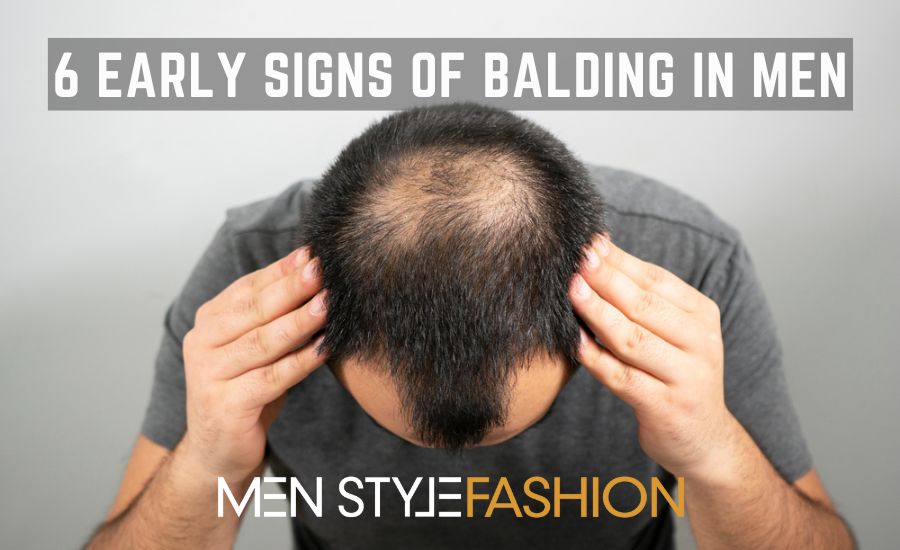Hair loss is a prevalent condition that affects men and women worldwide. Various factors can lead to baldness in both sexes, although men are more predisposed to it for multiple reasons.
The American Hair Loss Association reports that androgenetic alopecia, also known as male pattern baldness (MPB), is responsible for 95% of hair loss in men. The organization has also discovered that about 85% of men in their 50s are balding.
The normal range for daily hair loss rate is 50 to 100 strands. Anything above it can alarm most people. In some cases, excessive hair shedding can be caused by several stressors, including hormonal changes, certain illnesses, and starting or taking off certain medications.
So, how do you know if you’re experiencing temporary hair loss or should consider surgical and non-surgical hair replacement?
Let’s look at the most common and early signs of balding in men.

Hair thinning
Losing luscious locks is the most prevalent early sign of male pattern baldness. However, if you think that this condition only affects middle-aged men, think again. According to the AMLA, one in four persons suffering from genetic baldness will experience symptoms before turning 21.
Hair thinning is often evident in the following sections of one’s head:
Temples
Men with MPB count this as the first sign of eventual baldness, typically alongside receding hairline. The temple, which covers the hair growth on the side of the head and runs from between the ears, eyes, and forehead, can result in the infamous widow’s peak or a V-shaped hairline.
Thinning hair at the temples is also a common sign of female pattern baldness. While MPB is almost always hereditary, thinning hair along the temples can be caused by stress, hormonal changes, and nutritional deficiencies in men and women.
Top of the head
Unlike hair thinning along the temples, this hair loss symptom is less obvious and tends to happen slower. This gradual hair loss is also a sign of baldness in both men and women, where genetics play a big role. Thinning hair can add years to a man’s appearance and understandably erodes their confidence, especially on a romantic date or when dealing with other people.
Across the whole head
It’s possible to experience thinning in different hair sections. Unlike men, it’s rare for women to experience a receding hairline, but they’re more prone to this hair problem, especially as they age. Most patients may notice wider spots when they part their hair while combing.
Receding hairline
A hairline recession happens in males and can result from several factors, such as aging, genetics, over-styling, certain health conditions, and nutritional deficiencies. A receding hairline can start as thinning hair, especially along the temples, and continually worsen until growing as far away from your forehead as possible.
However, in most cases, the hairline on the sides recedes faster than in the middle, forming an M-shaped hair growth.
Bald spots and patches
There are different types of alopecia or hair loss in people. To the uninitiated, alopecia is an autoimmune condition that causes your body to attack the hair follicles, preventing hair growth.
A person with alopecia totalis will have a completely bald scalp, whereas alopecia universalis is a rare condition that leaves a patient completely hairless. The most common case, called alopecia areata, causes patchy bald spots on a person’s body hair, including the eyebrows, eyelashes, and scalp.
Losing hair all over your body
As mentioned, alopecia can result in hair loss on different body parts besides the scalp. If you’ve noticed a hair-free on your face, arms, and legs, it could be a sign of this condition. Certain health conditions and ageing can also slow hair or stop growth.
Significant hair fall
Race generally determines hair structure, density, and regrowth rates. Ethnicity aside, an individual has 120,000 hair strands on average and loses up to 100 daily. But the hair’s life cycle consists of continual growth, resting, and shedding phases.
On the other hand, hair loss is typically gradual and could start as early as a person hits puberty. However, some adults will notice dramatic hair loss triggered by many factors, including hormonal fluctuations and stress. Large clumps of falling hair can also happen if you use too many chemicals and products or engage in unhealthy practices.
While not all significant hair shedding indicates permanent hair loss, it’s crucial to seek professional help to determine its cause. In some cases, it might be temporary and could indicate health issues. However, if it’s been happening for long periods and at excessive rates, it could be a warning sign of permanent hair loss.
Slow-growing hair
The NCBI-published study cited earlier discovered that Asian females grow six inches of hair per year. In comparison, Caucasians and Africans increase their tresses by over five and four inches during the same period. Additionally, it takes two to six years before hair strands fall and get replaced.
If you notice that your hair is growing at an oddly slower pace, it can be a sign that you’re bound to go bald in the coming years.
Final thoughts
Temporary and permanent hair loss triggers include genetics, stress, certain medications, health conditions, and nutritional deficiencies. It’s important to seek medical help to determine the cause and manage the issue effectively.
If certain health conditions cause baldness, it’s best to address it first with your doctor’s help. Afterwards, you can tackle appearance issues by exploring surgical and non-surgical hair replacement solutions based on your goals and budget.
















